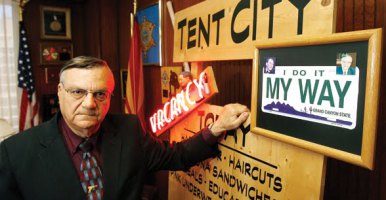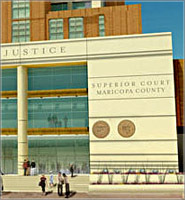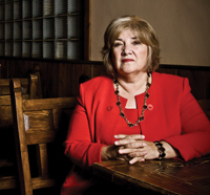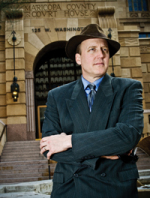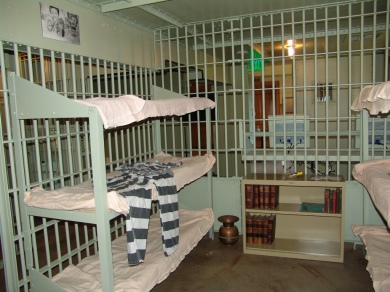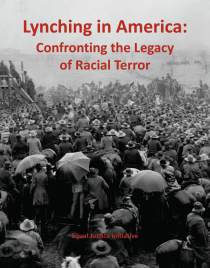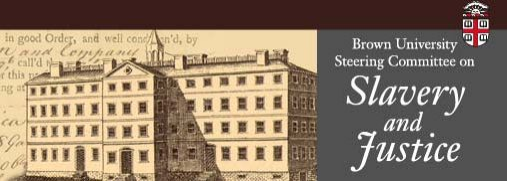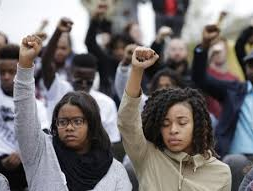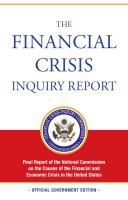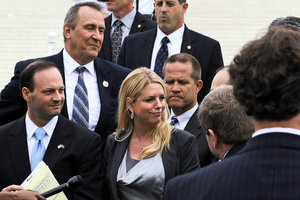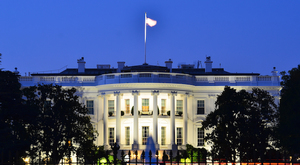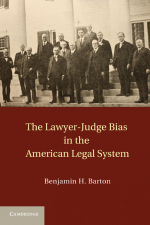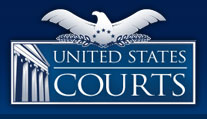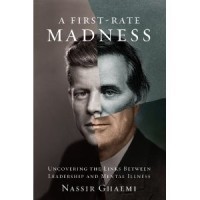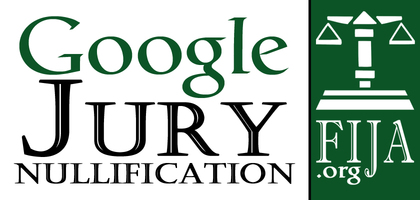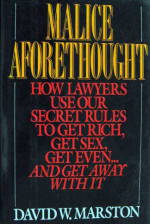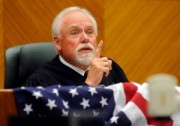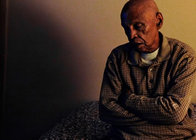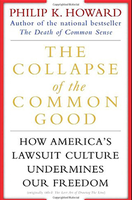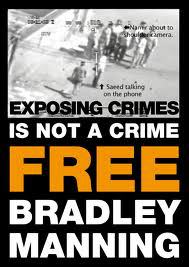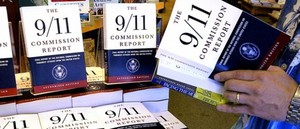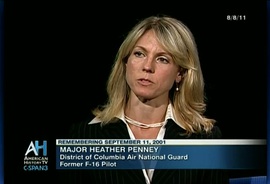The Maricopa Courthouse War
Hispanics still treated differently during traffic stops in county once policed under Arpaio: audit
Hispanics still treated differently during traffic stops in county once policed under Arpaio: audit
ABA Journal Online
By Terry Carter
September 27, 2017
The likelihood of Hispanics being stopped and searched by sheriff’s deputies in Maricopa County, Arizona, is still significantly greater than that for whites according to an audit by criminal justice researchers at Arizona State University, The Associated Press reports.
The study looked at 31,000 traffic stops from July 2015 through June 2016 and researchers found the "likelihood of Hispanics being arrested or searched over time has not decreased, or even changed," according to the audit report, whose authors had conducted an earlier, similar study. "Conversely, the length of stop for Hispanic drivers, while still longer than whites, decreased across years."
The racial profiling continued after a federal judge in 2013 ruled that then-Sheriff Joe Arpaio’s office violated the Constitution by targeting and detaining Hispanics suspected of having entered the country illegally, and subsequently approved a plan for an independent monitor in the agency to ensure the practice would end.
In May 2016, Judge G. Murray Snow found Arpaio in civil contempt for defying an injunction concerning immigration arrests. He was found guilty in July but pardoned by President Donald Trump on Aug. 25. The pardon is being challenged in court.
After 24 years as sheriff, Arpaio was defeated last November by Paul Penzone. Read more
DOJ Threatens to Sue Sheriff Joe Arpaio for Civil Rights Violations - ABA Journal Law News Now
DOJ Threatens to Sue Sheriff Joe Arpaio for Civil Rights
Violations
ABA Journal Law News Now
By Debra Cassens Weiss
April 4, 2012
The U.S. Justice Department is threatening to sue a controversial Arizona sheriff for civil rights violations because of his treatment of Hispanics.
The department’s civil rights division revealed a possible lawsuit after settlement talks broke down with Maricopa County Sheriff Joe Arpaio, according to Reuters and the Washington Post. "We believe
that you are wasting time and not negotiating in good faith," the department said in a letter to Arpaio’s lawyer.
A Justice Department report released in
December accused the sheriff’s department of using racial profiling against Hispanics in police stops and denying them services in jail.
The DOJ says Arpaio’s lawyers have twice called off settlement negotiations at the last minute, according to the Post account. After cancelation of a March 1 meeting,
Arpaio held a news conference to claim President Obama’s birth certificate is a forgery. Now Arpaio is complaining about the feds’ demand for a court-appointed monitor.
"To the Obama administration, who is attempting to strong arm me into submission only for its political gain, I say: This will not happen, not on my watch!" Arpaio said
in a statement published by Reuters. Read more
U.S. Investigation (PDF) of the Maricopa County Sheriff’s Office
Related Coverage
ABA Journal: “The Prosecutor on Trial: Ex-Maricopa County Attorney Faces Disbarment for Political Acts”
ABA Journal: "The Maricopa Courthouse War"
justice-department-findings-in-its-inves[...]
Adobe Acrobat document [1.3 MB]
DOJ Threatens to Sue Sheriff Joe Arpaio [...]
Adobe Acrobat document [23.9 KB]
The Prosecutor on Trial_ Ex-Maricopa Cou[...]
Adobe Acrobat document [156.8 KB]
The Maricopa Courthouse War - ABA Journal
ABA Journal
By Terry Carter
April 1, 2010
On Dec. 21, in the afternoon sunshine that passes for winter in Phoenix, several hundred well-dressed protesters—most of them lawyers—gathered on the Maricopa County courthouse plaza.
Summoned by an e-mail from a local lawyer, they brought handmade signs that were quaint by protest standards: "Rule of Law!" "Free Judges/Free People."
Holding handouts, they recited the oath they gave when joining the bar, their voices rising for the last section: "I will not counsel or maintain any suit or proceeding that shall appear to me to be without merit or to be unjust."
The immediate cause of their concern was a charge of bribery filed against a local superior court judge. Announced in vague terms at a news conference some days earlier, the charge was brought without indictment by the local prosecutor, Maricopa County Attorney Andrew Thomas.
But the criminal complaint against Judge Gary Donahoe was the last straw for these Phoenix-area lawyers, who had watched hardball politics overpower Maricopa’s courts.
The day after the protest, Yavapai County Attorney Sheila Polk, whose offices had been drawn into the mess in Maricopa, wrote in the Arizona Republic: "I can no longer sit by quietly and watch from a distance. … I am conservative and passionately believe in limited government, not the totalitarianism that is spreading before my eyes."
Alongside Thomas, at the center of all this, is Maricopa County Sheriff Joe Arpaio, the 77-year-old lawman whose caustic and controversial approach to crime and criminals has earned him the moniker "America’s toughest sheriff." To the glee of Maricopa County voters, "Sheriff Joe" has become nationally famous for his "tent city" jail, chain gang labor and very public inmate marches designed to humiliate—featuring pink handcuffs and pink underwear.
But since teaming up with then-38-year-old Thomas in 2005, Arpaio’s county reign has become steeped in charges of racism, cronyism and a widespread use of law enforcement and criminal prosecution to settle increasingly bitter political intrigues. The bribery action against Donahoe—though later dropped—is but one ugly incident in a four-year history of investigation and litigation that has cost Maricopa County millions in legal fees. And a growing number of local lawyers say they’ve had enough.
"I’ve lived in New Jersey and in Washington, D.C., where politics can get nasty," says Clint Bolick, director of the Phoenix-based Goldwater Institute’s Scharf-Norton Center for Constitutional Litigation."But here, normal political retribution is just the starting point."
Attempts to interview Arpaio were unavailing; Thom as’ spokesman, Barnett Lotstein, handled questions.
"This isn’t a personal thing with Thomas, like some others allege," Lotstein says about the most recent dust-ups. "This is like in The Godfather—this is business, not personal."
‘PERP-WALK’ POLITICS
Still, a federal grand jury in Phoenix is now investigating alleged abuses of power in Maricopa, a county that encompasses the nation’s fifth-largest metropolitan area and a population—4 million—greater than 24 states. And even a quick look at just the last few months in Maricopa County reveals a pattern of confrontation that is complicated, relentless and bizarre.
In December, Thomas announced the indictment of two members of the county board of supervisors. Don Stapley and Mary Rose Wilcox were charged, respectively, with fraud and with failing to properly register conflicts of interest.
Stapley, a frequent critic of Arpaio and Thomas, had been indicted by prosecutors nearly two years before on 118 similar charges. When the last of those charges were dismissed in September, Arpaio’s deputies re-arrested him in the county parking lot three days later and "perp-walked" him before the media—without charges or warrant—citing probable cause.
Thomas has since been removed from the case. All charges against Wilcox and Stapley have been dropped, as well as those against Judge Donahoe. A judge from another county ruled that Thomas had conflicts of interest. And the State Bar of Arizona is apparently investigating allegations that Thomas ignored warnings that the charges against Wilcox were not legitimate, as well as an earlier warning that conflicts precluded him from investigating Stapley.
On Dec. 1, the day before the Stapley-Wilcox indictments, Thomas and Arpaio filed a federal civil suit (PDF) against the county’s board of supervisors and several judges, charging them with conspiracy and racketeering. In essence, the supervisors were accused of cutting the budgets of the sheriff and prosecutor during a countywide belt-tightening, while they continued with the long-planned construction of a new building for the county’s courts.
Public meetings have been marred by Arpaio’s deputies. In December 2008, five people were arrested after they applauded criticism of Arpaio at a meeting of the county board. The cases were dismissed last November by a county justice of the peace. The JP, Steven McMurry, noted that the deputies were "aided and abetted by the county attorney" and ordered the county to pay the defendants’ legal fees. "It has to stop," McMurry said.
Last summer and again in mid-December, Arpaio’s deputies visited the homes of county employees, seeking information about their bosses and supervisors.
In November, a sheriff’s deputy was held in contempt for taking confidential papers from a defense lawyer’s files while she was speaking to the judge. The deputy decided he would rather be jailed than apologize, even though the incident was caught on a courtroom camera. Arpaio, whose office provides bailiffs for the courts, called his employee a "political prisoner." His deputies staged a "sickout" and refused to bring prisoners to the courthouse. There was a bomb scare. The courts were closed for two days.
By the time of the lawyer protest, more than two dozen lawyers had filed motions seeking to move criminal cases out of Maricopa County, saying Thomas now had the judges in fear of ruling against him. That very day, Chief Justice Rebecca White Berch of the Arizona Supreme Court began triage. She issued an order appointing her predecessor, retired Chief Justice Ruth McGregor, as a special master to take control of the fast-deteriorating situation.
The various investigations, cases, motions, and allegations of conflicts and conspiracy, Berch wrote, "have the potential to impair the court’s ability to carry out its responsibilities and threaten the perception of impartial justice." And if conflicts forced the wholesale transfer of cases away from the county, "a public safety emergency would arise."
A LATE-NIGHT ARREST
The Arpaio-Thomas alliance was slow in developing. But it was embroiled in controversy from the start.
In their first meeting in February 2005, just a month after the prosecutor was sworn in, the sheriff asked Thomas to bring charges against a reporter at the Phoenix New Times, a local alternative newspaper—something Thomas’ predecessor, no fan of the sheriff, would have been reluctant to do.
Arpaio’s power is legend. He commands the equivalent of an Army combat brigade, with more than 3,500 employees and a $270 million budget.
An internal memo in Thomas’ office called the New Times matter stale and weak but noted that "Sheriff Joe Arpaio is demanding that this case be charged. … Latest call indicated that there would be problems between the sheriff’s office and the county attorney’s office if this case is not charged."
Thomas said he had a conflict, so he sent the case to his counterpart in nearby Pinal County, where it languished for two years. Later, after Arpaio and Thomas had become allies, Thomas appointed an independent prosecutor, private attorney Dennis Wilenchik.
Wilenchik, a civil litigator who made his bones in construction-defect and toxic-mold cases, had hired Thomas to work in his law office in 2003 while Thomas was preparing his run for county attorney. Once elected, Thomas sent outside work to Wilenchik that, by early 2010, amounted to $4.1 million in less than five years.
Wilenchik launched the Arpaio case by issuing a breathtakingly broad grand jury subpoena. He demanded lists of confidential sources, reporters’ notebooks and information about each of the hundreds of thousands of visitors to the newspaper’s website over the previous three years. When the paper’s owners published a story about the subpoena’s reach, Arpaio had them arrested.
“Arpaio’s deputies came to their homes and arrested them at 11 p.m. that night in plain clothes and black sedans—one of them with Mexico tags,” says Michael C. Manning, who represents the newspaper in a suit against Arpaio, “for goddamn misdemeanors.”
Backlash was so intense that Thomas dropped the charges less than 24 hours later.
It was not litigation, however, but the hot-button issue of immigration that finally forged an alliance between the seemingly mismatched public officials.
After graduating from Harvard Law School in 1991, Thomas worked briefly in private practice in Phoenix. He then entered public service, working for the attorney general, the governor and the Department of Corrections. He failed in a run for AG in 2002 and then briefly handled low-level matters as an assistant Maricopa County attorney, leaving in 2003 to begin a run for the office when the incumbent decided not to seek re-election.
Thomas fashioned himself as a conservative pundit in the mid-1990s, though his harder edges offended some in his partisan audience. In The Weekly Standard in 1997 he blamed our criminal and social ills on “the moral laissez-faire disorder of libertarianism.”
Thomas campaigned in 2004 to “stop illegal immigration.” Though federal law covers immigration, it struck a chord with Maricopa voters.
This was the moment of the Minuteman Project, launched in April 2005. The group began patrolling U.S. borders with Mexico, unnerving federal law enforcement while stirring anti-illegal-immigration sentiment.
By the end of his first year in office, Thomas had taken on the superior court judges, challenging Spanish-language probation hearings in DUI cases. Though the program was designed to help probationers understand their obligations, Thomas criticized them as “race-based courts.”
Though Thomas spent thousands of dollars on Spanish-language public service announcements bear-ing his face and name, he sued in federal court to stop the Spanish proceedings. After $498,000 in litigation fees, the 9th U.S. Circuit Court of Appeals at San Francisco ruled against Thomas last July, noting in the first sentence of its opinion that the county attorney lacked standing as a matter of “well-settled precedent.”
“Some say the county lost that case, but it’s never been ruled on the merits,” says Lotstein, Thomas’ spokesman. “It was brought for a simple reason—we don’t believe in discrimination.”
ON LOCAL AUTHORITY
Thomas also pursued his crusade against illegal immigration on another, even more controversial track. Thomas sought the lead over federal authorities in immigration enforcement within the county, and Arizona legislators gave him the tools, including a human smuggling statute known as the “coyote law” that targets those who charge fees to transport undocumented foreigners across the U.S. border.
Thomas said the illegal immigrants were as guilty as the coyotes. His novel reasoning combined the new human smuggling law with Arizona’s conspiracy statute: Both the smuggler and the person being smuggled were involved in the felony. Of Arizona’s 15 counties, only Maricopa applies that interpretation.
“Thomas really did want to create his own little INS,” says Phoenix public defender Robert McWhirter, immediate-past president of the Arizona Attorneys for Criminal Justice and the author of two books on immigration law published by the ABA.
Arpaio, who had close ties with the Hispanic community, was at first on a different page.
“The sheriff’s greater efforts at the time were against the Mexican Mafia, which was sending hit men into Maricopa County to carry out executions,” says super visor Wilcox, a fourth-generation Mexican-American. Those who didn’t pay for their crossing or otherwise angered the smugglers were killed. It was an epic turf battle for Arpaio. Also, she says, “he always had an af finity and a really good understanding of the Hispanic community.”
But the sheriff had a Damascene conversion in April 2005, when an Iraq war veteran held seven Mexicans at gunpoint at a rest stop on Interstate 8, suspecting they were illegal aliens. Arpaio’s deputies, however, arrested the veteran.
“You don’t go around pulling guns on people,” Arpaio told reporters. “Being illegal is not a serious crime. You can’t go to jail for being an illegal alien. … You can only be deported.”
Arpaio suddenly found himself on unfamiliar ground, being savaged on talk radio and in letters to the editor for being soft on crime. After 11 days, Thomas dropped the charges.
“Sheriff Arpaio wanted some of the attention Thomas was getting on immigration,” says Wilcox, who with her husband owns El Portal, a popular Sonoran-style restaurant at the edge of downtown Phoenix. “At first his deputies started coming down on taco vendors and peddlers, the visible small commerce that is part of the Hispanic community.”
Both Wilcox and Stapley, her colleague on the board, publicly criticized the anti-illegal-immigration efforts, in addition to confronting Thomas and Arpaio in budget matters. Arpaio responded by publicly ratcheting up local immigration enforcement efforts.
“My message to the illegals is this: Stay out of Maricopa County, because I’m the sheriff here,” Arpaio told the Washington Post little more than a year after he had pronounced illegal immigration “not a serious crime.”
By 2008 the sheriff began sending hundreds of troops to run sweeps in mostly Hispanic neighborhoods. Heavily armed deputies, sometimes in SWAT regalia, were accompanied by civilian members of Arpaio’s posse. They stopped vehicles for minor infractions such as burned-out taillights or cracked windshields and asked for documentation of citizenship.
While Arpaio has helped carry out Thomas’ local immigration enforcement program, Thomas—and Maricopa County—have spent millions defending Arpaio.
Manning is a commercial litigator, the managing partner in Phoenix for Kansas City, Mo.-based, 330-lawyer Stinson Morrison Hecker. In the late 1990s, he took on the case of a lawyer friend whose son died of asphyxiation while tied down and unconscious in a restraint chair in county custody. The case settled for $8.25 million.
Similar cases found him. Half of the more than $40 million paid out in litigation against Arpaio over the years has gone to Manning’s clients.
Twice in 2009, Manning says, Arpaio’s deputies parked in front of his house in marked cars, watching, “just to let me know they were there.”
Since taking office, Thomas has doubled county spending on outside counsel—often with his closest political contributors, critics say. And concern over unwieldy spending and a lack of accountability have put Thomas and Arpaio at war with what seems like the rest of Maricopa County government.
“Thomas was paying out exorbitant amounts of money, and we felt that some of that work could have been done by his staff lawyers,” Wilcox says. “Our risk management people were telling us that things were not going well, and you could see it. We just kept losing cases.”
In May 2006 the board decided it would have some say in such outside hiring, as it had with Thomas’ predecessor. Thomas sued the board for encroaching on his turf.
Stapley told a columnist for the Arizona Republic that Thomas “wants to use [the contract work] as a political lever for his own campaign contributions.”
In his news release announcing his suit, Thomas switched sides in two lawsuits against the board. He said he could no longer defend the board in litigation brought by the county’s school superintendent and the medical examiner because “I believe these two complaints have merit.”
After the board threatened to take the matter to the state bar as an ethics complaint against Thomas, he and the board soon signed a memorandum of understanding. Thomas would dismiss his suit. The board could veto any new lawyers or law firms proposed for the list of those eligible for county contracts. The board agreed not to file a bar complaint against Thomas; Thomas agreed not to sue the board.
Its last item read: “This MOU terminates on Dec. 1, 2008.”
On Dec. 2, Thomas announced Stapley’s indictment.
CONFLICT ON CONFLICTS
Though Thomas and his office had advised the board on financial disclosures, Stapley was indicted on 118 counts concerning them. About half were felonies bootstrapped from underlying misdemeanors.
At the bottom of the wrangling, however, was money. Like other local governments working through tighter times, the board had slated 12 percent across-the-board budget cuts, including the offices of the county attorney and sheriff. Both bristled at the proposal, especially Arpaio.
In a letter to the board, copied to Thomas, Arpaio suggested tapping funds set aside for the county’s long-anticipated Downtown Court Tower. The $347 million project had been in planning for 12 years and the board declined to scrap it.
Shortly after Stapley was indicted, the board decided it had had enough. Board members sought outside counsel to see whether Thomas had violated their attorney-client relationship. Thomas responded with a sweeping grand jury subpoena seeking information about the courthouse project.
The board hired Tom Irvine, a Phoenix attorney, to represent members’ interests and to determine whether Thomas had ethical conflicts by serving as board adviser to the county business he had decided to investigate. When Irvine moved to quash the grand jury subpoena because of the prosecutorial conflicts, Thomas announced that Irvine, too, was part of the investigation.
Irvine says the courthouse project investigation and the litigation surrounding the board amounts to hardball politics: “[Thomas and Arpaio] said, ‘Well, if they want to investigate our ethics, we’ll go after something [board members] like.’ ”
What followed, however, was more turmoil than politics. When members of the board had their offices swept for bugs, Thomas said they were obstructing the investigation. When five people attending a board meeting cheered a speaker’s criticism of Arpaio, sheriff’s deputies arrested them. The emboldened board stripped $6 million from the county attorney’s budget to set up their own civil shop; Thomas sued.
In February 2009, in closed proceedings, Judge Donahoe—the judge later charged criminally—ruled that Thomas, in fact, had a conflict in his dealings with the county. His attempts to investigate a board that he represented had “the appearance of evil,” Donahoe wrote, citing an old Arizona case. In March, a former state bar official was questioned in Flagstaff by two Maricopa deputies regarding potential “intimidation” in his investigation of an ethics complaint against Thomas.
The courthouse conflict roiled through the summer, spawning a series of accusations, lawsuits and court hearings. Arpaio’s office intensified its investigations of county employees and supervisors, as Thomas continued to battle the board in the courts while also fighting the courts.
As the conflicts escalated, Maricopa courts began to assign visiting judges, retired judges and even a special master to sort out the various cases. Through an assistant, Lisa Aubuchon, Thomas filed a flurry of requests to the Arizona Court of Appeals asking for intervention, suggesting that his office was faced with “a coordinated attempt by senior Maricopa County Superior Court officials to undermine the prosecution … and shut down related criminal investigations.”
Last August, after losing several court battles over access to judicial branch e-mails, 12 armed deputies seized the county computer room—“just intimidating the employees working there and trying to show the [county] board that they could take over a resource that wasn’t theirs,” said County Manager David Smith, according to press reports.
About that time, half the charges against Stapley were dismissed by a visiting judge, and prosecutors were forced to drop the rest. Thomas’ attempt to hire Joseph diGenova and his wife, Victoria Toensing—two former prosecutors, now television celebrities—to conduct the courthouse investigation gained no traction under county procurement rules.
Arpaio’s office has long been dogged by questions relating to elections and budgets—including his use of proceeds from the sale of pink box ers to fans. Last year, the county’s chief procurement officer alerted the prosecutor to the sheriff’s purchase of a bus for $456,000—more than twice what the county usually pays for buses—without open bidding and outside official channels, a potential criminal violation. There is no evidence that Thomas did anything but ignore the letter, and the bus has remained parked without tags since its delivery last May.
But resistance against Thomas and Arpaio—once thought to be unassailable—is mounting.
When the county elections director asked Thomas last summer to investigate what he believed to be a secret election slush fund—some of it from Arpaio’s top depu ties—Thomas balked. The state attorney general later opened an investigation.
In March 2009, the U.S. Justice Department notified Arpaio that it was investigating “alleged … discriminatory police practices and unconstitutional searches and seizures.”
“Sheriff Arpaio has been entertaining for voters through five elections, but the show has become a dangerous reality,” says attorney David Bodney. “Particularly for brown-skinned persons in vehicles during his sweeps.”
Bodney is a longtime partner in the Phoenix office of Washington, D.C.’s Steptoe & Johnson. He represents the American Civil Liberties Union of Arizona in a suit against Arpaio.
THE FINAL STRAW
In February, U.S. District Judge Murray Snow sanctioned the sheriff’s department for shredding significant documents that should have been turned over in discovery.
Even the conservative Goldwater Institute has expressed concern that Arpaio’s department has been ignoring serious and violent crimes—often clearing them without investigation—in favor of chasing illegal immigrants. When the institute took its concerns to Thomas they were ignored, says Bolick. "Andrew Thomas told me he didn’t want to further inflame the political problems in the county."
In November, on behalf of the county board and its members, Smith filed a formal complaint with the state bar against Thomas and several of his prosecutors, complaining that members of Thomas’ staff had been waging their own campaign against county officials through the courts and on the Internet.
On Dec. 9, the fray over the courthouse project, the costly cross-litigation and the raw racial tension generated by Arpaio’s immigration sweeps brought Maricopa past the boiling point.
That afternoon, Judge Donahoe was scheduled to conduct a hearing on Thomas’ plan to hire diGenova and Toensing as special prosecutors in the courthouse case.
Complaining that the hearing itself would harm his grand jury investigation, Thomas instead announced that he had filed bribery charges against Donahoe.
At a press conference that afternoon—with Arpaio at his side—Thomas attempted to explain that under Arizona’s very broad bribery laws, the new courthouse project could be considered an inducement to judges who, like Donahoe, were hampering his investigation.
"If I’m not explaining this well, I hope you’ll help me," he told stunned reporters.
Many lawyers in Phoenix say that single, embarrassing moment—perhaps more than anything—has gal vanized and energized opposition to Thomas and Arpaio. Inexplicable criminal charges against a well-respected judge brought lawyers of all persuasions to protest on the county’s courthouse steps. It also gave more than good reason for state and federal authorities to dig deeper in their ongoing probes.
In January, the Justice Department launched a new grand jury probe into the alleged abuses of power against political foes. Among the panel’s first witnesses were several county officials: the county manager, the head of computer services and Arpaio’s financial officer. Ominously, witnesses were encouraged to speak to the media about their testimony—apparently to insulate them from potential harassment.
Paul Charlton, a former Republican-appointed U.S. attorney for Arizona, who has represented Stapley, says he is not surprised that a backlash has finally set in. Charlton was one of the U.S. attorneys fired in 2006 by Attorney General Alberto Gonzales, in a controversial—some say political—purge. Gonzales lost his job in the subsequent firestorm.
"That kind of arrogance has its Watergate eventually," says Charlton. "I think here it will be the charging of Judge Donahoe."
Web Extras:
Pending Death Penalty Cases Weigh Against Maricopa County
Correction
In "The Maricopa Courthouse War," April, the last name of Deputy
County Attorney Lisa Aubuchon was misspelled. Also, Judge Gary Donahoe was described incorrectly as having been arrested after a criminal complaint was brought against him; he was not arrested, and
those charges were recently dismissed.
The ABA Journal regrets the errors.



